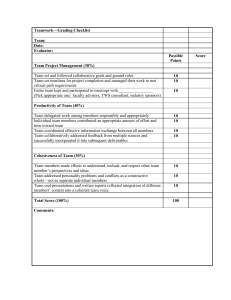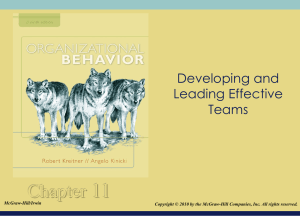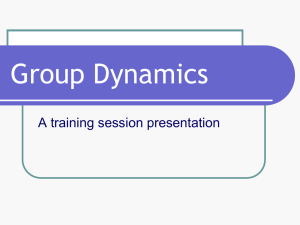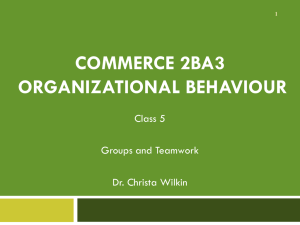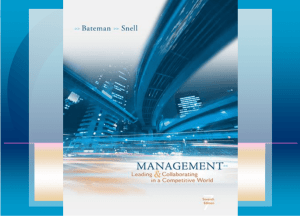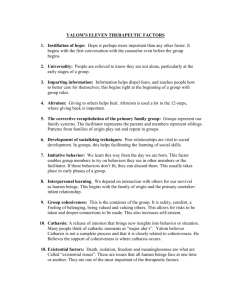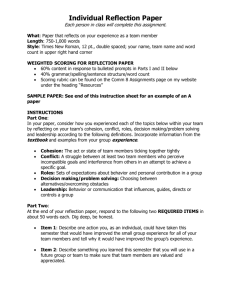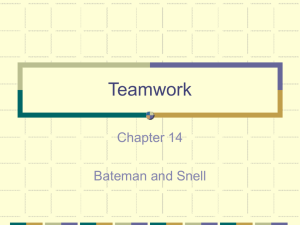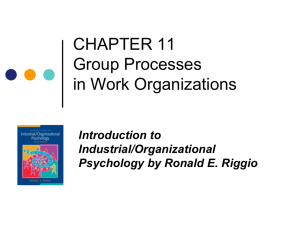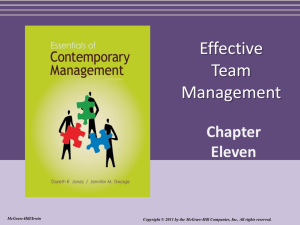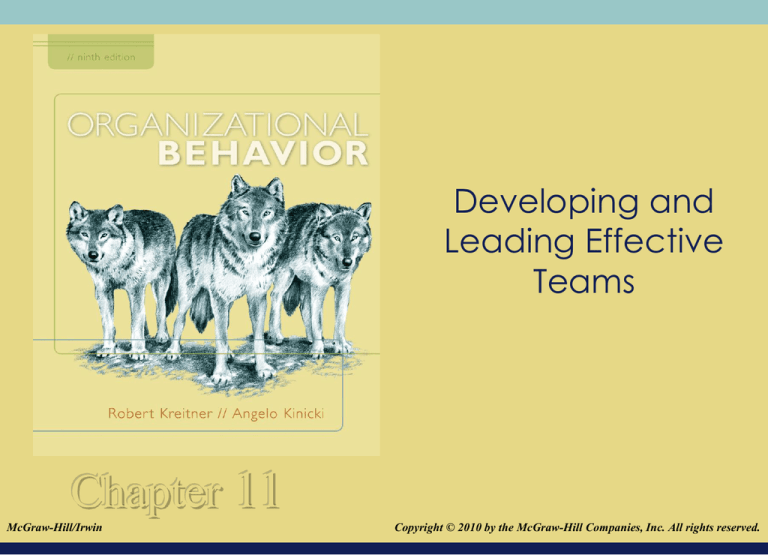
Developing and
Leading Effective
Teams
Chapter 11
McGraw-Hill/Irwin
Copyright © 2010 by the McGraw-Hill Companies, Inc. All rights reserved.
© 2008The McGraw-Hill Companies, Inc. All rights reserved.
Ch. 11 Learning Objectives
1. Explain how a work group becomes a team.
2. Identify and describe four types of work
teams.
3. Explain the model of effective work teams,
and specify the two criteria of team
effectiveness.
4. Identify five teamwork competencies team
members need to possess.
5. Discuss why teams fail.
11-2
Ch. 11 Learning Objectives
6. List at least four things managers can do to
build trust.
7. Distinguish two types of group cohesiveness,
and summarize cohesiveness research
findings.
8. Define virtual teams and self-managed teams
9. Describe high-performance teams and
discuss team leadership.
11-3
Teams
Team Small group with
complementary skills who
hold themselves mutually
accountable for common
purpose, goals, and
approach
11-4
Evolution of Teams
A Work Group Becomes a Team When:
1)
2)
3)
4)
5)
Leadership becomes a shared
activity
Accountability shifts from
strictly individual to both
individual and collective
The group develops its own
purpose or mission
Problem solving becomes a way
of life, not a part-time activity
Effectiveness is measured by
the group’s collective outcomes
and products
11-5
Teams
What are the
characteristics of a
successful basketball
team?
What parallels can
we make to work
teams?
11-6
Types of Work Teams
11-7
Effective Work Teams
11-8
Teamwork Competencies
Orients Team to
Problem-solving
Situation
Organizes and
Manages Team
Performance
Promotes a Positive
Team Environment
Facilitates and Manages
Task Conflict
Appropriately
Promotes Perspective
11-9
Characteristics of Effective Teamwork
11-10
Why Work Teams Fail
11-11
Effective Teamwork Requires:
Cooperation rather than
competition
• Within teams
• Among teams within
organizations
Trust reciprocal faith in
others’ intentions and
behavior
Cohesiveness a sense of
“we-ness”, strength of team
members’ desires to remain a
part of the team
11-12
Interpersonal Trust Involves a Cognitive Leap
Cognitive leap
Faith in the other person’s
good intentions
Assumption that other person
will behave as desired
Firsthand knowledge
of other person’s
reliability and
integrity
Distrust
Trust
What can you do to build trust?
11-13
Cohesiveness
A sense of “we-ness” helps
the group stick together
Socio-emotional
cohesiveness
• Sense of togetherness based
on emotional satisfaction
Instrumental cohesiveness
• Sense of togetherness based
on mutual dependency
needed to get the job done
11-14
Test Your Knowledge
Military units engaged in coordinated
efforts involving life or death situations
would most likely rely on
a. Socio-emotional cohesiveness
b. Instrumental cohesiveness
11-15
Enhancing Cohesiveness
11-16
Test Your Knowledge
1.
2.
3.
4.
5.
True (A) or False (B)
Too much team cohesiveness can be a
problem for the organization.
In general, success leads to cohesion, rather
than cohesion causing success
Smaller teams are more cohesive
External threats hurt team cohesiveness
Members of cohesive teams enjoy more
satisfaction and less turnover
11-17
Teams in Action: Basic Distinctions
11-18
How to Manage Virtual Teams
Establish regular times for group
interaction
Set up firm rules for
communication
Use visual forms of communication
where possible
Emulate the attributes of colocated teams
Give and receive feedback and
offer assistance on a regular basis
Agree on standard technology so
all team members can work
together easily
11-19
How to Manage Virtual Teams
Consider using 360-degree feedback to better
understand and evaluate team members
Provide a virtual meeting room via intranet,
web site, or bulletin board
Note which employees effectively use e-mail to
build team rapport
Smooth the way for an employee’s next
assignment if membership on the team, or the
team itself is not permanent
Be available to employees, but don’t wait for
them to seek you out
Encourage informal, off-line conversations
between team members
11-20
Test Your Knowledge
Joachim is the leader of a virtual team. Due to time zone
differences, the team has difficulty finding times to meet
but found a time for a conference call today. Aileen, a
fellow team member, was supposed to make a
presentation to the group but never dialed into the call.
In order to preserve the relationships among team
members, after the conference call Joachim should:
a. send an email to Aileen's boss regarding her absence
from the call.
b. complain to team members about Aileen's behavior.
c. call Aileen directly to inquire about her absence from
the call.
11-21
Ways to Empower Self-Managed Teams
11-22
Attributes of High Performance Teams
1) Participative
leadership
2) Shared responsibility
3) Aligned on purpose
4) High communication
5) Future focused
6) Focused on task
7) Creative talents
8) Rapid response
11-23
Self-Management Leadership Behaviors
1)
2)
3)
4)
5)
6)
Encourages selfreinforcement
Encourages selfobservation/evaluation
Encourages selfexpectations
Encourages self-goalsetting
Encourages rehearsal
Encourages self-criticism
11-24

